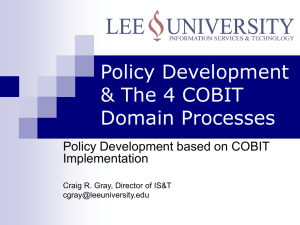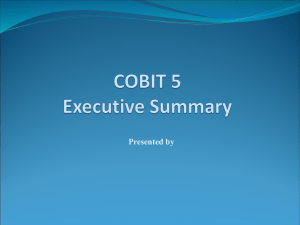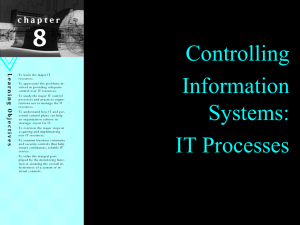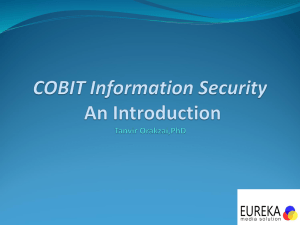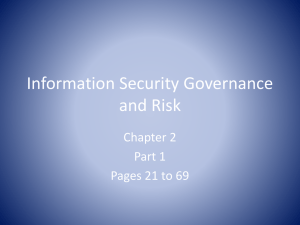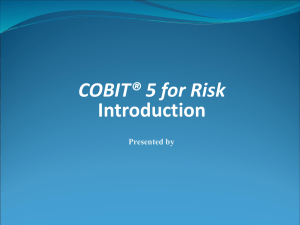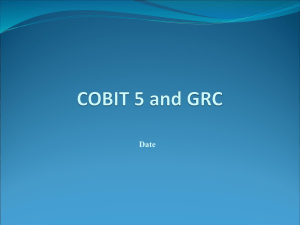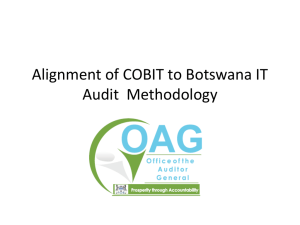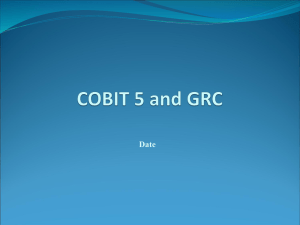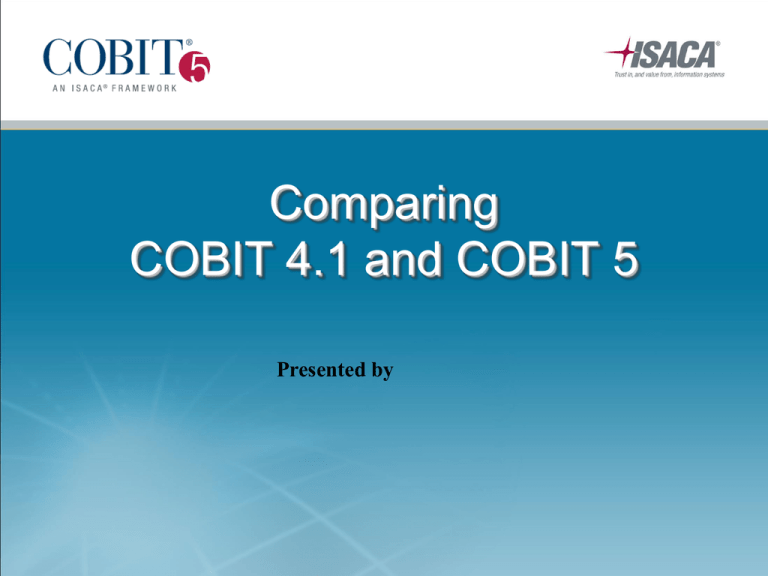
Comparing
COBIT 4.1 and COBIT 5
Presented by
Transition Message
• COBIT 4.1, Val IT and Risk IT users who are
already engaged in governance of enterprise IT
(GEIT) implementation activities can transition to
COBIT 5 and benefit from the latest and
improved guidance that it provides during the
next iterations of their enterprise’s
improvement life cycle.
• COBIT 5 builds on previous versions of COBIT
(and Val IT and Risk IT) and so enterprises can
also build on what they have developed using
earlier versions.
© 2012 ISACA.
All rights reserved.
2
Stakeholder Value and
Business Objectives
• Enterprises exist to create value for their
stakeholders. Consequently, any enterprise—
commercial or not—will have value creation as a
governance objective.
• Value creation means: Realising benefits at an
optimal resource cost while optimising risk.
© 2012 ISACA.
All rights reserved.
3
Stakeholder Value and
Business Objectives (cont.)
Principle 1:
Meeting Stakeholder Needs
• Stakeholder needs have to be
transformed into an
enterprise’s actionable
strategy.
• The COBIT 5 goals cascade
translates stakeholder needs
into specific, actionable and
customised goals within the
context of the enterprise,
IT-related goals and enabler
goals.
© 2012 ISACA.
All rights reserved.
4
Stakeholder Value and
Business Objectives (cont.)
• Stakeholder needs can be related to a set of
generic enterprise goals.
• These enterprise goals have been developed
using the Balanced Scorecard (BSC) dimensions.
(Kaplan, Robert S.; David P. Norton; The Balanced Scorecard: Translating
Strategy into Action, Harvard University Press, USA, 1996)
• The enterprise goals are a list of commonly used
goals that an enterprise has defined for itself.
• Although this list is not exhaustive, most
enterprise-specific goals can be easily mapped
onto one or more of the generic enterprise goals.
© 2012 ISACA.
All rights reserved.
5
Stakeholder Value and
Business Objectives (cont.)
© 2012 ISACA.
All rights reserved.
6
Stakeholder Value and
Business Objectives (cont.)
• The goals cascade is not ‘new’ to COBIT.
• It was introduced in COBIT 4.0 in 2005.
• Those COBIT users who have applied the
thinking to their enterprises have found value.
• BUT not everyone has recognized this value.
• The goals cascade supports the COBIT 5
stakeholder needs principle that is fundamental
to COBIT and has therefore been made
prominent early in the COBIT 5 guidance.
• The goals cascade has been revisited and
updated for the COBIT 5 release.
© 2012 ISACA.
All rights reserved.
7
Governance and Management
Defined
• What sort of framework is COBIT?
– An IT audit and control framework?
• COBIT (1996) and COBIT 2nd Edition (1998)
• Focus on Control Objectives
– An IT management framework?
• COBIT 3rd Edition (2000)
• Management Guidelines added
– An IT governance framework?
• COBIT 4.0 (2005) and COBIT 4.1 (2007)
• Governance and compliance processes added
• Assurance processes removed
• BUT what is the difference between governance
and management?
© 2012 ISACA.
All rights reserved.
8
Governance and Management
Defined (cont.)
• Governance ensures that enterprise objectives are
achieved by evaluating stakeholder needs, conditions
and options; setting direction through prioritisation and
decision making; and monitoring performance,
compliance and progress against agreed-on direction
and objectives (EDM).
• Management plans, builds, runs and monitors
activities in alignment with the direction set by the
governance body to achieve the enterprise objectives
(PBRM).
© 2012 ISACA.
All rights reserved.
9
Governance and Management
Defined (cont.)
The COBIT 5 process reference model subdivides the ITrelated practices and activities of the enterprise into two
main areas—governance and management—with
management further divided into domains of processes:
• The GOVERNANCE domain
contains five governance
processes; within each process,
evaluate, direct and monitor
(EDM) practices are defined.
• The four MANAGEMENT
domains are in line with the
responsibility areas of plan,
build, run and monitor (PBRM)
© 2012 ISACA.
All rights reserved.
10
Areas of Change
• The following slides summarise the major changes
in COBIT 5 content and how they may impact
GEIT implementation/improvement:
1.
2.
3.
4.
5.
6.
7.
8.
9.
© 2010 ISACA.
New GEIT Principles
Increased Focus on Enablers
New Process Reference Model
New and Modified Processes
Practices and Activities
Goals and Metrics
Inputs and Outputs
RACI Charts
Process Capability Maturity Models and Assessments
All rights reserved.
11
1. New GEIT Principles
COBIT 5 Principles
© 2012 ISACA.
All rights reserved.
12
1. New GEIT Principles (cont.)
• Val IT and Risk IT frameworks are
principles-based.
• Feedback indicated that principles are easy to
understand and put into an enterprise context,
allowing value to be derived from the supporting
guidance more effectively.
• ISO/IEC 38500 also incorporates principles to
underpin its messages to achieve the same
market benefit delivery, although the principles
in this standard and COBIT 5 are not the same.
© 2012 ISACA.
All rights reserved.
13
2. Increased Focus on Enablers
• COBIT 4.1 did not have enablers! Yes it did—
they were not called enablers, but they were
there, explicitly or implicitly!
© 2012 ISACA.
All rights reserved.
14
2. Increased Focus on Enablers (cont.)
• Information, infrastructure, applications
(services) and people (people, skills and
competencies) were COBIT 4.1 resources.
• Principles, policies and frameworks were
mentioned in a few COBIT 4.1 processes.
• Processes were central to COBIT 4.1 use.
• Organisational structure was implied through the
responsible, accountable, consulted or informed
(RACI) roles and their definitions.
• Culture, ethics and behaviour were mentioned in
a few COBIT 4.1 processes.
© 2012 ISACA.
All rights reserved.
15
3. New Process Reference Model
• COBIT 5 is based on a revised process
reference model with a new governance domain
and several new and modified processes that
now cover enterprise activities end-to-end—i.e.,
business and IT function areas.
• COBIT 5 consolidates COBIT 4.1, Val IT and
Risk IT into one framework, and has been
updated to align with current best practices—
e.g., ITIL, TOGAF.
• The new model can be used as a guide for
adjusting as necessary the enterprise’s own
process model (just like COBIT 4.1).
© 2012 ISACA.
All rights reserved.
16
3. New Process Reference Model (cont.)
© 2012 ISACA.
All rights reserved.
17
4. New and Modified Processes
• COBIT 5 introduces five new governance
processes that have leveraged and improved
COBIT 4.1, Val IT and Risk IT governance
approaches.
• This guidance:
– Helps enterprises to further refine and strengthen
executive management-level GEIT practices and
activities
– Supports GEIT integration with existing enterprise
governance practices and is aligned with
ISO/IEC 38500
© 2012 ISACA.
All rights reserved.
18
4. New and Modified Processes (cont.)
• COBIT 5 has clarified management level
processes and integrated COBIT 4.1, Val IT and
Risk IT content into one process reference model
© 2012 ISACA.
All rights reserved.
19
4. New and Modified Processes (cont.)
• There are several new and modified processes
that reflect current thinking, in particular:
•
•
•
•
•
•
•
•
•
•
•
© 2012 ISACA.
APO03 Manage enterprise architecture.
APO04 Manage innovation.
APO05 Manage portfolio.
APO06 Manage budget and costs.
APO08 Manage relationships.
APO13 Manage security.
BAI05 Manage organisational change enablement.
BAI08 Manage knowledge.
BAI09 Manage assets.
DSS05 Manage security service.
DSS06 Manage business process controls.
All rights reserved.
20
4. New and Modified Processes (cont.)
• COBIT 5 processes now cover end-to-end
business and IT activities—i.e., a full
enterprise-level view.
• This provides for a more holistic and complete
coverage of practices reflecting the pervasive
enterprisewide nature of IT use.
• It makes the involvement, responsibilities and
accountabilities of business stakeholders in the
use of IT more explicit and transparent.
© 2012 ISACA.
All rights reserved.
21
5. Practices and Activities
• The COBIT 5 governance or management
practices are equivalent to the COBIT 4.1 control
objectives and Val IT and Risk IT processes.
www.isaca.org/Journal/Past-Issues/2011/Volume-4/Pages/Where-Have-Allthe-Control-Objectives-Gone.aspx
• The COBIT 5 activities are equivalent to the
COBIT 4.1 control practices and Val IT and Risk
IT management practices.
• COBIT 5 integrates and updates all of the
previous content into the one new model,
making it easier for users to understand and use
this material when implementing improvements.
© 2012 ISACA.
All rights reserved.
22
6. Goals and Metrics
• COBIT 5 follows the same goal and metric
concepts as COBIT 4.1, Val IT and Risk IT, but
these are renamed enterprise goals, IT-related
goals and process goals reflecting an enterprise
level view.
• COBIT 5 provides a revised goals cascade based
on enterprise goals driving IT-related goals and
then supported by critical processes.
• COBIT 5 provides examples of goals and metrics
at the enterprise, process and management
practice levels. This is a change to COBIT 4.1, Val
IT and Risk IT, which went down one level lower.
© 2012 ISACA.
All rights reserved.
23
7. Inputs and Outputs
• COBIT 5 provides inputs and outputs for every
management practice, whereas COBIT 4.1 only
provided these at the process level.
• This provides additional detailed guidance for
designing processes to include essential work
products and to assist with interprocess
integration.
© 2012 ISACA.
All rights reserved.
24
8. RACI Charts
• COBIT 5 provides RACI charts describing roles
and responsibilities in a similar way to
COBIT4.1, Val IT and Risk IT.
• COBIT 5 provides a more complete, detailed
and clearer range of generic business and IT
role players and charts than COBIT 4.1 for each
management practice, enabling better definition
of role player responsibilities or level of
involvement when designing and implementing
processes.
© 2012 ISACA.
All rights reserved.
25
8. RACI Charts (cont.)
© 2012 ISACA.
All rights reserved.
26
9. Process Capability Maturity Models
and Assessments
• COBIT 5 discontinues the COBIT 4.1, Val IT and
Risk IT CMM-based capability maturity modelling
approach.
• COBIT 5 will be supported by a new process
capability assessment approach based on ISO/IEC
15504, and the COBIT Assessment Programme
has already been established for COBIT 4.1 as an
alternative to the CMM approach.
www.isaca.org/Knowledge-Center/cobit/Pages/COBIT-Assessment-Programme.aspx
• The COBIT 4.1, Val IT and Risk IT CMM-based
approaches are not considered compatible with
the ISO/IEC 15504 approach because the methods
use different attributes and measurement scales.
© 2012 ISACA.
All rights reserved.
27
9. Process Capability Maturity Models
and Assessments (cont.)
COBIT 4.1/5
© 2012 ISACA.
All rights reserved.
28
9. Process Capability Maturity Models
and Assessments (cont.)
• The COBIT Assessment Programme approach
is considered by ISACA to be more robust,
reliable and repeatable as a process capability
assessment method.
• The COBIT Assessment Programme supports:
– Formal assessments by accredited assessors
(assessor training is being developed)
– Less rigorous self-assessments for internal gap
analysis and process improvement planning
• The COBIT Assessment Programme, in the
future, will also potentially enable an enterprise
to obtain an independent and certified
assessments aligned to the ISO/IEC standard.
© 2012 ISACA.
All rights reserved.
29
9. Process Capability Maturity Models
and Assessments (cont.)
• What materials support the COBIT Assessment
Programme approach?
– COBIT Process Assessment Model (PAM): Using COBIT 4.1—
Serves as a base reference document for the performance of a
capability assessment of an organisation’s current IT processes
against COBIT
– COBIT Assessor Guide: Using COBIT 4.1—Provides details on
how to undertake a full ISO-compliant assessment
– COBIT Self-assessment Guide: Using COBIT 4.1—Provides
guidance on how to perform a basic self-assessment of an
organisation’s current IT process capability levels against COBIT
processes
• The above materials exist to support
COBIT 4.1-based assessments now; versions will
be produced to support COBIT 5-based
assessments.
© 2012 ISACA.
All rights reserved.
30
9. Process Capability Maturity Models
and Assessments (cont.)
• COBIT 4.1, Val IT and Risk IT users wishing to
move to the new COBIT Assessment
Programme approach will need to realign their
previous ratings, adopt and learn the new
method, and initiate a new set of assessments in
order to gain the benefits of the new approach.
• Although some of the information gathered from
previous assessments may be reusable, care
will be needed in migrating this information
forward because there are significant differences
in requirements.
© 2012 ISACA.
All rights reserved.
31
9. Process Capability Maturity Models
and Assessments (cont.)
• COBIT 4.1, Val IT and Risk IT users wishing to
continue with the CMM-based approach, either
as an interim or ongoing approach, can use the
COBIT 5 guidance, but must use the COBIT 4.1
generic attribute table without the high-level
maturity models.
© 2012 ISACA.
All rights reserved.
32

